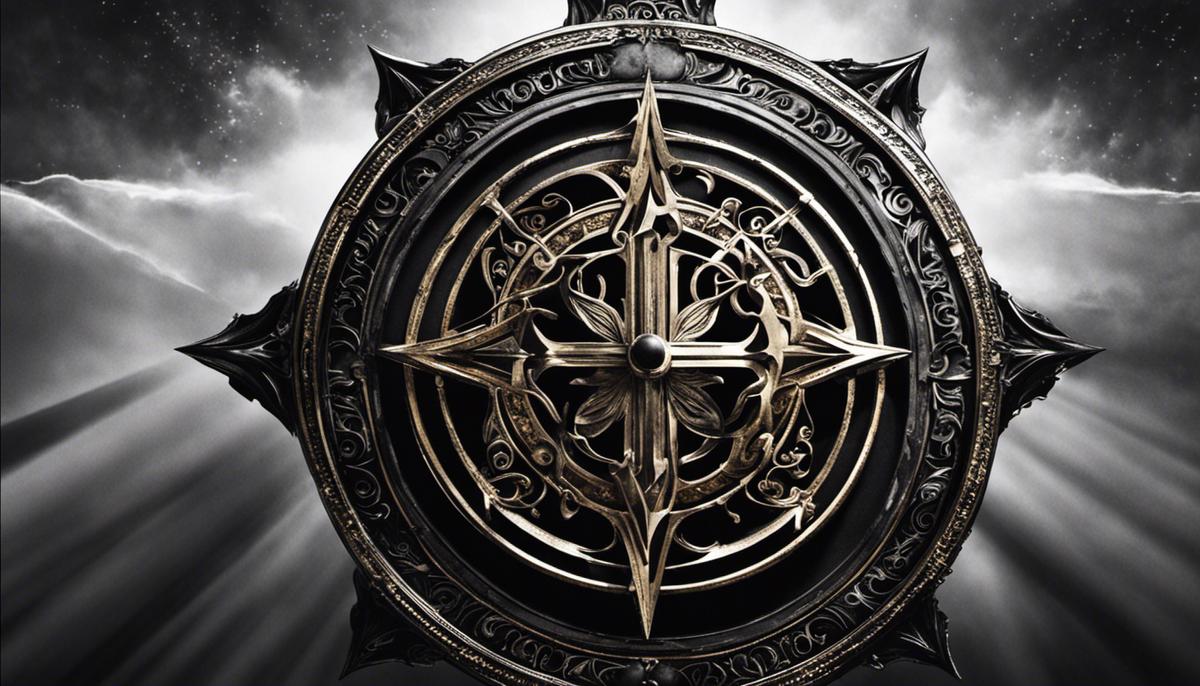The realm of dreams has long captivated the human imagination, sparking debate among various fields of science, philosophy, and religion. Dreams bridge the gap between our conscious and subconscious mind, often leading to profound revelations about our deeply held beliefs, fears, and aspirations. Among these symbolic manifestations, black bears recur frequently, evoking a wide array of interpretations.
This discursive exploration delves into the biblical symbolism of seeing a black bear in dreams. The journey begins with an examination of the role of bears in biblical references, followed by an understanding of the symbolism of the color black in the Bible. We then engage with universally accepted theories of dream interpretation before ultimately concentrating on the specific interpretation of black bears as dream symbols.
Bears in Biblical References
The Significance of Bears in Biblical Literature
Bears hold a powerful position in the Bible, where their appearances, though limited, are deeply symbolic and understatedly impactful. Their roles underline an array of key themes and narratives in Biblical tradition. To discern the substance behind these references, a comprehensive review of the literal and metaphorical aspects of these fascinating creatures in Biblical literature remains imperative.
Firstly, bears are prominently considered as symbols of raw power and strength, seen in both physical and spiritual contexts. Proverbs 28:15 delineate, “Like a roaring lion or a charging bear is a wicked ruler over a poor people,” which effectively exhibits the bear as an embodiment of potent authority. Surprisingly, the masculine implications often associated with bears are overshadowed by their frequent personification as females, particularly mothers, in the Bible.
Male bear’s conspicuous absence from the Biblical text enhances the emphasis on the maternal figure of the bear. In Hosea 13:8, the bereaved mother bear is portrayed as a symbol of divine vengeance: “I will fall upon them like a bear robbed of her cubs.” The natural fierceness and territoriality intrinsic in mother bears are evoked here, bridging the chasm between the realms of natural order and divine judgement. This magnifies the gravity of transgressions and the severity of divine retribution, capturing the powerful dynamics of justice in Biblical tradition.
Furthermore, 2 Kings 2:23-24 narrates the startling account of Elisha and the She-bears, a story often interpreted to illustrate consequences of disrespect towards God’s prophets. The usage of bears in this episode amplifies the Divine’s capacity to invoke elements from the natural world to enforce spiritual consequences, signifying a profound intersection of natural reality and spiritual principles.
In contrast to the vengeful embodiments, bears are also vehicles of moral instruction. The tale of David fighting the bear before moving on to face Goliath suggests predestination in action, permeating the lesson of trust in divine intervention (1 Samuel 17:34-37). Here, the bear additionally symbolizes trials and challenges one must overcome in preparedness for larger future encounters, enhancing the threads of faith and premonition within Christian teachings.
In other instances, the bear serves as a chilling reminder of the demarcation between civilization and the wild. The bear is not a domesticated animal. Its presence frequently alludes to wilderness, disorder, and imminent danger. Therefore, the depiction of bears in biblical context can be seen as a reminder of the continuous struggle between order and chaos, between accepted societal norms and the untamed natural world.
In conclusion, the bear in the Bible signifies more than a mere animal; it is a multifaced symbol portrayed as a cosmic force, a spiritual agent, and a moral guide. This reification of the bear in Biblical literature confers upon it an array of diverse roles and representations, reflecting the rich intricate tapestry that is Biblical tradition. Consequently, understanding the bear’s roles extends the knowledge on Biblical symbolism, inviting further exploration into this intriguing literary landscape.

Symbolism of Black Color in The Bible
Tracing the Shadow: Black as a Symbol in Biblical Discourse
The color black, in biblical symbolism, weaves a nuanced tapestry encapsulating the paradoxes of creation, both embodying life’s dark periods, metaphysical despair, and the emergence of divine wisdom. This multifaceted color concept holds transcendent significance, expressing the cyclic nature of human experience and divine revelation.
In biblical literature, especially in poetry and prophecies, black often forecasts calamity, signifying mourning, sorrow, and divine judgment. It represents the absence of light, the obscuration of divine favor, and, as such, a prophetic metaphor for the spiritual and physical desolation that comes with God’s wrath, as seen in Jeremiah 14:2, “Judah mourns, her cities languish; they wail for the land, and a cry goes up from Jerusalem.”
Furthermore, black becomes a symbol of deep-seated cultural anxieties regarding the human existence’s fragility. In Job 30:28 and 30, the color encompasses the somber atmosphere of Job’s despair, linking his profound melancholy to the disorientation and loneliness of his suffering.
However, the dynamic symbolism of black is intricately complex, with it also manifesting as an embodiment of divine wisdom. This wisdom often reveals itself through the struggles of despair, as marked by the paradox of the black yet comely bride in Song of Solomon 1:5. Here, black signifies the beauty borne from the refining kiln of affliction and transformation.
Interestingly, the image of the black horse in Revelation 6:5-6 serves as another example of this symbolism’s complexity. While it symbolizes impending famine, its rider holds a pair of balances, indicating divine justice. Thus, black engenders a dire warning, yet it concurrently stands as a reminder of God’s just nature, balancing the scales of human actions.
In essence, the use of black in biblical symbolism is indicative of a balance: the stark truths of human affliction and divine judgment on one hand, but also the transmutation of suffering into wisdom, spiritual growth, and divine justice on the other. It serves as a testament to the complexity and subtlety of the human relationship with the divine, material, and spiritual realms, tying the temporal to the eternal in a spectrum of sacred colors. The symbolism pertinent to black in biblical literature is a poignant reminder that the true depths of understanding lie in grappling not just with the light, but also with the enlightening darkness. Despite surface appearances, one can uncover the intricate layers of interpretation only through textual observance, scholarly diligence, and an appreciation for the Bible’s rich semiotic canvas.

General Dream Interpretation Theories
Interpreting dreams has enthralled scholars and scientists for millennia, leading to a proliferation of theories and research. These interpretations are deeply embedded in various fields including psychology, theology, and literature, each bringing its unique perspective to this complex science. We will embark on a brief expedition to further explore these diverse interpretations, following a trajectory that spans from ancient philosophies to contemporary scientific models.
A notable early perspective of dream interpretation originates from Ancient Egypt, where dreams were considered supernatural communications, divine messages brimming with profound meanings. Committed to parchment in repositories such as the famed Egyptian Dream Book, these interpretations imbued dreams with an array of mystical connotations, often linked with predictive features indicating prosperity, misfortune, or divine episodes.
Whilst the Egyptians assigned prophetic value to dreams, the Greco-Roman world, notably with Aristotle and Artemidorus, began to perceive dreams as personal narratives intertwined with the dreamer’s mind and experiences. This perspective emphasized the psychological underpinnings of dreams, an antecedent to modern psychoanalytic theories.
The inception of psychology introduced significant shifts in the interpretation of dreams, most notably through the groundbreaking work of Sigmund Freud and Carl Jung. For Freud, dreams operated as ‘the royal road to the unconscious,’ uncovering repressed desires, whilst Jung proposed the idea that dreams reveal personal and collective unconscious through archetypal symbolism. This transformation elucidates the mind’s intricate landscapes, turning attention toward the self’s internal machinations and conflicts.
Recent dream research within the realm of neurobiology and cognitive psychology has sought to unravel the neurophysiological processes involved in dreams. Notably, Allan Hobson’s Activation-Synthesis hypothesis proposes that dreams are our brain’s attempt to synthesize and interpret random neural activity during REM sleep. Moreover, theories such as Domhoff’s neurocognitive model suggest that dreams are a form of thinking that is shaped by our waking cognitive abilities, interests, and concerns.
In theology and literature, dreams have been understandably intertwined with symbolic and narrative features. This is reflected in a myriad of religious texts, revealing dreams as conduits of divine revelation, moral edification, and prophesy. Extending beyond the realm of the sacred, dreams in literature often convey profound insights into a character’s psyche or unveil pivotal plot developments.
Interestingly, a prominent strand within cultural anthropology examines dreams as conduits of socio-cultural information. This perspective unearths how people’s dream narratives are influenced by their societal norms, beliefs, and values. Here, dreams offer a unique window into cultural worlds, illuminating shared values and societal dynamics.
Overall, the realm of dream interpretation is complex and multifaceted, encompassing a range of specialties and disciplines. This exploration underscores the significance of dreams and their inscrutable power that continues to captivate scholars and scientists. Even as research methods evolve and paradigms shift, dreams remain an enigmatic frontier, echoing the profound depth and diversity of human consciousness and our ceaseless curiosity to comprehend its mysteries.

Specific Dream Interpretation: Black Bear
When considering the symbolism of a black bear in a dream from a biblical perspective, it is important to approach the topic with a multidimensional viewpoint, given the profound and rich symbolism found in biblical literature.
Unlike commonly used symbols in biblical dreams such as water, bread, or animals like sheep, the appearance of a bear – specifically a black bear in one’s dream – is somewhat uncommon and could signify several things. Therefore, understanding what it could mean requires a careful study that takes into consideration several elements.
Let’s proceed with the significance of dreams in biblical literature. Dream imagery in the Bible often serves as divine revelation and acts as a conduit for God’s communication to humanity (Genesis 28:12-17; Daniel 2:19,28). Therefore, the appearance of a black bear in a dream could be a form of divine message. This interpretation, however, must be discerning and align with the consistent teachings in Scripture, indicating the need for an in-depth theological understanding and exegesis.
Black bears are imposing creatures known for their strength, power, and solitary nature. From previous analysis, the symbolism attached to bears and the color black could be combined in understanding what it means to dream of a black bear. Thus, a black bear might represent the physical embodiment of raw power laden with divine judgement or inevitable consequences. It could signify a looming threat, impending doom, mourning, or forewarning of a divine sent trial.
However, it is not all about impending, unavoidable dangers. Taking into consideration the role bears play as vehicles of moral instructions and the symbolism of black as an embodiment of divine wisdom – a black bear consequently could serve as a divine channel of transformation and learning. It might highlight the necessity for personal growth through trials.
We must also note the relevance of specific contextual factors, not excluding the overall context of the dream, personal life circumstances of the dreamer, and their unique spiritual realities. As dream interpretations are subjective, it requires a profound understanding of the individual’s situation.
Furthermore, it’s important to consider cultural variances, as interpretations can be influenced by socio-cultural factors. For example, the view of black bears among Native American cultures contrasts greatly with many modern Western perceptions, posing the need for contextual sensitivity.
To conclude, comprehending the symbolism behind a black bear in a dream assessed from a biblical perspective requires a broad view that combines the interpretation of both the bear and black color symbolism in the Bible. Balancing the potential messages of divine judgment, transformation, danger, or wisdom, it ultimately synthesizes biblical symbolism, theological notions, cultural perceptions, psychoanalysis, and anthropological perspectives. The act of interpretation, then, becomes a rich intellectual endeavor that, while complicated, nurtures personal spiritual development and textual understanding.

Decoding the symbolic representation of black bears in dreams is a complex task that requires weaving together insights from multiple sources, contexts, and teachings. Each dream is a unique collage of our experiences, fears, desires, and cultural and spiritual upbringing. The art of dream interpretation, thus, continually evolves as a mirror of our individual and collective consciousness.
The knowledge gained from biblical references, the symbolic understanding of the color black, and the studied theories of dream interpretation offer a rich tapestry from which we can draw when interpreting the appearance of a black bear in our dreams. This process requests us to be reflective, open-minded and continually curious as we delve deeper into the enigmatic language of dreams.








